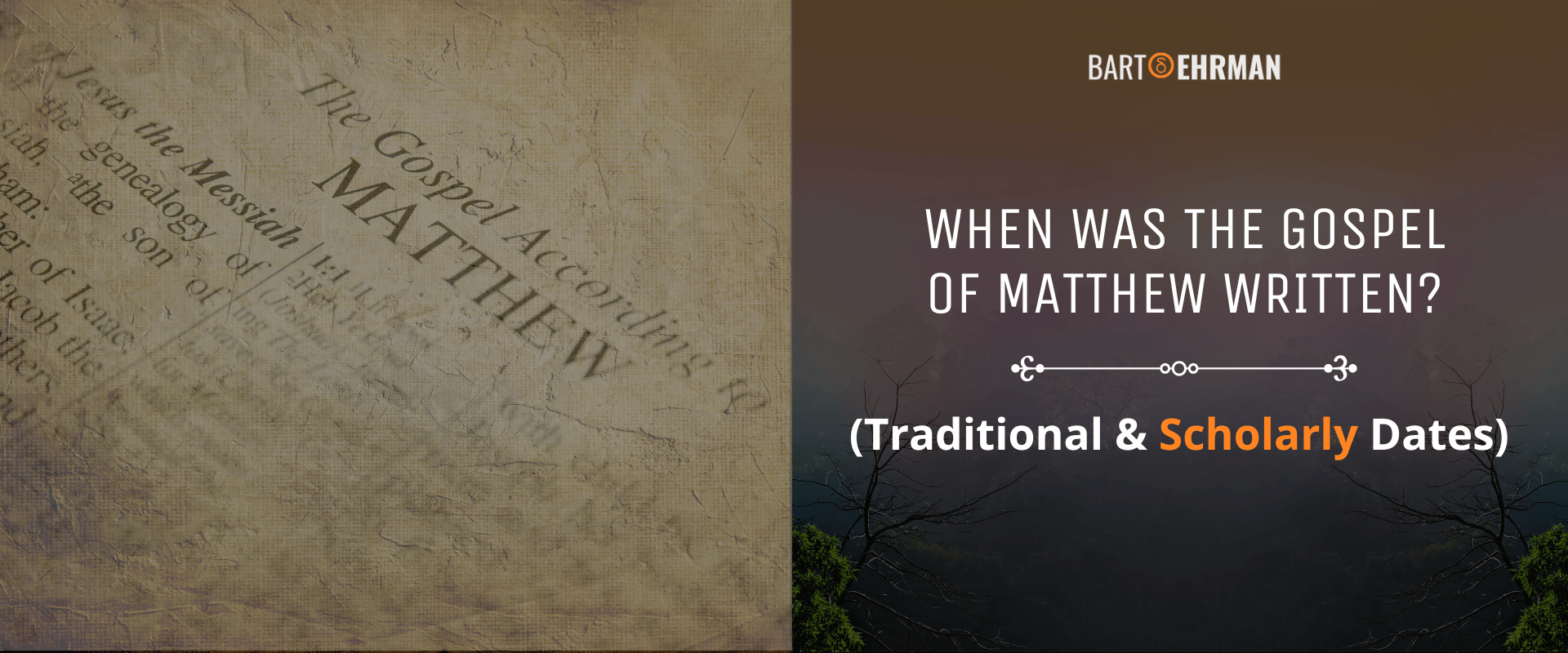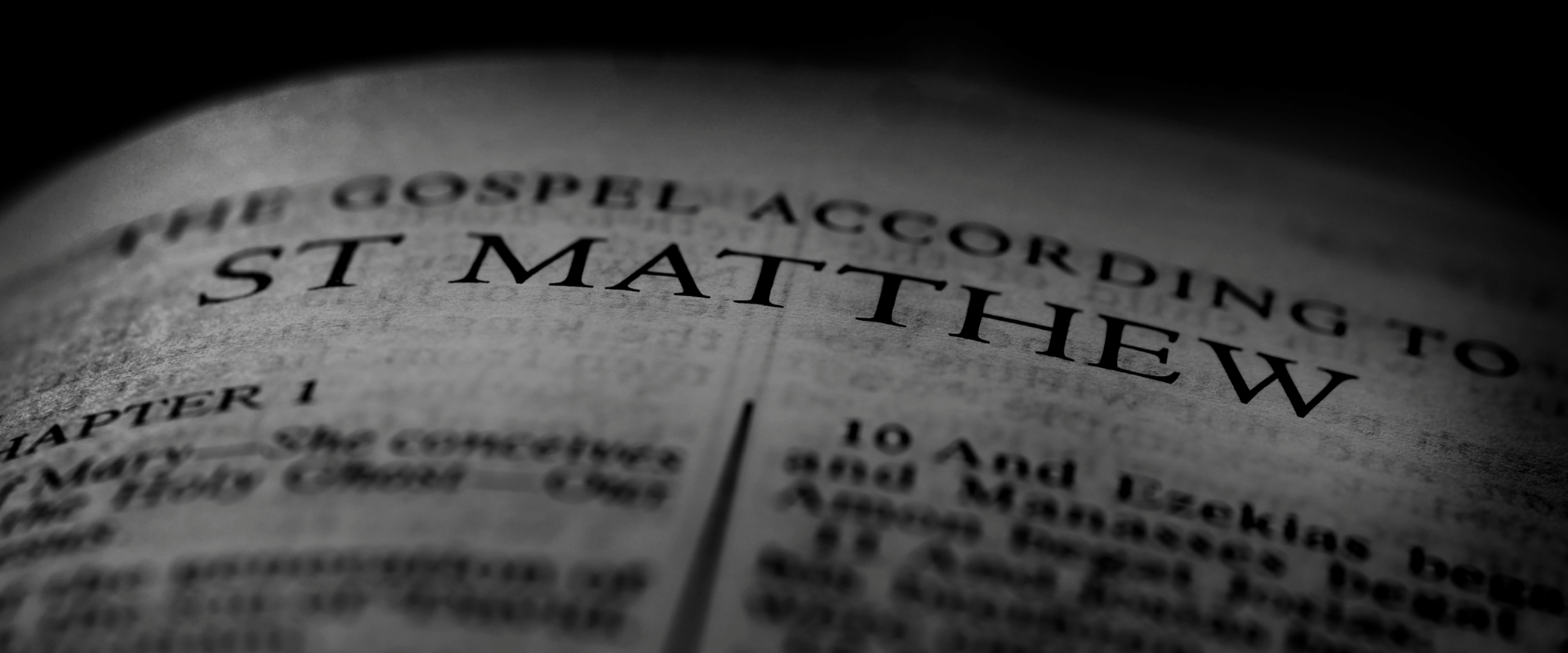When Was the Gospel of Matthew Written? (Traditional & Scholarly Dates)

Written by Marko Marina, Ph.D.
Author | Historian
Author | Historian | BE Contributor
Verified! See our guidelines
Verified! See our editorial guidelines
Date written: November 25th, 2024
Edited by Laura Robinson, Ph.D.
Disclaimer: The views and opinions expressed in this article belong to the author and do not necessarily match my own. - Dr. Bart D. Ehrman
When was the Gospel of Matthew written? Recently, I had the privilege of being a guest lecturer at the Faith&Politics forum, a fascinating event that hosted a range of influential figures from the European Parliament and regional countries. My topic? The Historical Jesus and His Political Context — a subject that practically begs for lively discussion.
I divided my presentation into two parts: First, I outlined the key challenges historians encounter when analyzing Jesus' life, from authorship questions to the dating of the Gospels; second, I zoomed in on the political landscape of first-century Judea, exploring Jesus' interactions (and tensions) with the power players of his time.
Although my lecture was decidedly political in focus, the Q&A session quickly veered back to my first section. Attendees were keenly interested in the Gospels’ origins, and, unsurprisingly, the dating of these texts became the evening’s unofficial theme.
One question stood out. An attendee asked me to compare the dating of the Gospels with that of other ancient biographies, suggesting that a shorter gap between Jesus’ life and the Gospels might somehow guarantee their historical reliability. This led to a broader discussion that, in the end, circled back to the very foundation of any historical analysis of Jesus: The dating of the Gospels.
It’s an issue that looms large, especially when reliability is in question — something my audience was grappling with. And so, here we are, about to tackle one of the most enduring questions in Biblical scholarship: When was the Gospel of Matthew written?
The date of Matthew’s Gospel isn’t just a footnote in history; it holds implications for understanding the development of early Christian thought, the Gospel’s intended message, and the community it addressed.
In the sections that follow, we’ll examine Matthew’s origin through a scholarly lens, beginning with a brief overview of the Gospel’s content and traditional author, before turning our focus to the main issue: When was the Book of Matthew written?
We’ll weigh traditional beliefs against modern scholarly consensus, thus uncovering how both sides have shaped our understanding of this foundational text.
But before we begin, I want to invite you to check out Bart D. Ehrman’s course “The Unknown Gospels: Matthew, Mark, Luke, and John.” In eight 30-minute lessons, Dr. Ehrman provides a scholarly analysis of the four New Testament Gospels, delineating authentic history from later tradition and myth.

Overview of Key Aspects of Matthew's Gospel
When was the Gospel of Matthew written? Before we begin answering that question, a short overview of its key aspects is necessary. So, in what follows, we’ll take a brief look at the authorship of Matthew’s Gospel, its summary, and the designated audience.
Who Wrote the Gospel of Matthew?
In exploring when the Gospel of Matthew was written, an essential part of our analysis involves the question of authorship. Traditionally, this Gospel has been attributed to Matthew, a tax collector and one of Jesus’ twelve disciples. Early church figures such as Irenaeus (late 2nd century C.E.) affirmed this view, thus providing one of the earliest external attestations.
However, most critical scholars today question this attribution. For one, the Gospel is anonymous; at no point does the author identify himself as Matthew or as any eyewitness. This lack of internal evidence leads scholars to search for other clues.
Notably, the Gospel shows signs of having used the Gospel of Mark as a source (more on that later!), which is puzzling if the author were indeed Matthew. As an eyewitness to Jesus' ministry, he would have been less reliant on secondhand accounts. Additionally, the sophisticated structure and language suggest a high level of literary skill, perhaps unlikely for a Galilean tax collector.
These factors lead most scholars to conclude that the Gospel was likely penned by an unknown author within a Jewish-Christian community. As Delbert Burkett notes in his Introduction to the New Testament: “The Gospel itself makes no claims concerning who wrote it. Modern scholarship therefore has to leave the author anonymous.”
(Affiliate Disclaimer: We may earn commissions on products you purchase through this page at no additional cost to you. Thank you for supporting our site!)
For those interested in a deeper dive into this debate, we have an entire article dedicated to examining the authorship of Matthew in detail. Make sure to check it out!
Intended Audience: To Whom Was the Gospel of Matthew Written?
Most critical scholars agree that the Gospel of Matthew was likely written for a Jewish-Christian audience. This conclusion is drawn from the text’s frequent references to Jewish customs, laws, and prophecies, often without explanatory context — an indication that the intended readers would have already been familiar with these traditions.
Matthew’s Gospel, more than any other, emphasizes Jesus as the fulfillment of Jewish prophecy, frequently citing the Hebrew Scriptures to frame Jesus as the long-awaited Messiah.
Furthermore, certain themes in Matthew, such as Jesus’ teachings on the law, indicate an interest in bridging the gap between Jewish tradition and the emerging Christian faith.
Rather than rejecting the Torah, in Matthew, Jesus reinterprets the Torah and expands on its ethical teachings — a perspective that would have resonated with Jewish Christians grappling with the question of how to preserve their heritage while embracing their faith in Jesus as the Messiah.
Regarding the precise community to whom “Matthew” wrote his account, secure answers evade us. In his book Introducing the New Testament, Mark A. Powell concludes:
Numerous details regarding the interpretation of this Gospel can be elucidated by the hypothesis that the book was written for believers in that setting, but it is not a sure thing, as other cities, similar to Antioch, fit the bill as well.
In case you want to know more, we have an entire article on this as well! All you need to do is click and read. You might find a surprising wealth of scholarly information!
The Gospel of Matthew: Short Summary
The Gospel of Matthew presents a unique portrayal of Jesus as the Messiah who fulfills Jewish prophecy, emphasizing his role as a teacher and moral guide. Structured around five major discourses — such as the Sermon on the Mount and teachings on the Kingdom of Heaven — Matthew highlights Jesus' ethical teachings and parables.
This Gospel also uniquely frames Jesus as the new Moses, thus providing instruction that deepens and fulfills the Law. For a deeper exploration of these themes and how they shape Matthew’s narrative, see our earlier article dedicated to the Gospel’s content and structure.
After providing a brief overview of the key aspects of the most popular New Testament Gospel, we can focus on the main question of this article: When was the Gospel of Matthew written?
FREE COURSE!
WHY I AM NOT A CHRISTIAN
Raw, honest, and enlightening. Bart's story of why he deconverted from the Christian faith.
Over 6,000 enrolled!
When Was the Book of Matthew Written: Assessing the Evidence
As you can probably imagine there are certain aspects of the New Testament history where the traditional (religious) and scholarly (historical) points of view collide. This precisely is the case with the question of when the Gospel of Matthew was written.
When Was the Gospel of Matthew Written: Traditional Theory
The traditional view holds that the Gospel of Matthew was written by the apostle Matthew, also known as Levi in other Gospels. Matthew was a tax collector who Jesus called to be one of his disciples.
Support for this theory primarily comes from early Christian testimony, notably from Papias, a bishop of Hierapolis in the early 2nd century. According to a fragment preserved by the historian Eusebius, Papias reported that “Matthew collected the sayings (or ‘logia’) of Jesus in the Hebrew language, and each one interpreted them as he could.”
Irenaeus, writing later in the 2nd century, explicitly affirmed this view, stating that Matthew composed his Gospel among the Hebrews in their language, shortly after Jesus’ life. Following Irenaeus, virtually every major Church figure — from Origen to Eusebius — accepted Matthew’s authorship, building a strong tradition around this attribution.
That brings us to the issue at hand: When was the Book of Matthew written? According to Church tradition, the Gospel of Matthew was believed to have been written relatively early, likely within the first few decades after Jesus’ death, around 50-60 C.E. This early date aligns with the traditional view that Matthew, a direct disciple of Jesus, authored the Gospel. At the same time, eyewitnesses to Jesus’ ministry were still alive.
Early Church figures, such as Irenaeus and Origen, implied that Matthew’s Gospel was among the earliest Christian texts, often suggesting that it was composed before the destruction of the Jerusalem Temple in 70 C.E.
This view has found some support among scholars. In his book Redating the New Testament, James A. T. Robinson remains skeptical of the internal evidence supporting the late dating of Matthew:
The period of composition commonly assigned to both Matthew and Luke (80-90) was, as far as we know, marked by no crisis for the church that would reawaken the relevance of apocalyptic [theme]... In any case, it is far too uncertain a piece of evidence to carry any weight by itself.
Robinson believes that Matthew was composed as early as the 60s. However, as much as earlier dating looks attractive, it has serious flaws. Consequently, most scholars have come up with a different conclusion, putting the composition of Matthew’s Gospel a couple of decades later. Let’s take a look!

When was the Book of Matthew Written: Scholarly Consensus
Scholars have long debated when the Gospel of Matthew was written, but most critical assessments place its composition between 80 and 90 C.E. This view begins by reevaluating the traditional testimony of Papias.
Firstly, the Greek Gospel of Matthew isn’t simply a collection of sayings or “logia” but a more developed narrative account of Jesus’ life, teachings, and resurrection. Secondly, the Gospel was composed in Greek, not Hebrew, as Papias implies.
While it’s natural to connect Papias’ reference to the only Gospel of Matthew we know, it’s equally plausible that he refers to a different, now-lost collection of Jesus’ sayings. Other collections, possibly attributed to a different “Matthew,” may have circulated in early Christian circles and could explain Papias' reference without tying it directly to our Gospel of Matthew.
A stronger argument for dating Matthew post-70 C.E. arises from the literary evidence, particularly the Gospel’s clear dependence on the Gospel of Mark. Most scholars agree that Mark was written shortly after the destruction of the Jerusalem Temple in 70 C.E.
Matthew incorporates large portions of Mark’s text, often verbatim, and rearranges or expands upon Mark’s material to suit his narrative and theological aims. This reliance on Mark — demonstrated through consistent verbatim agreements and a similar sequence of events — strongly suggests that Matthew’s Gospel was composed afterward.
Further literary evidence within the Gospel of Matthew itself also points to a date post-70 CE. Mark A. Powell explains:
Several matters in Matthew’s Gospel reflect the sort of concerns that Jewish people were dealing with in the decades after the destruction of the Jerusalem temple in 70 CE (cf. 24:1–2): How is God present with us? What is the continuing value of the Torah? How and when will God’s promises to Israel be fulfilled?
Matthew’s theological and ecclesiological development further supports this dating. The Gospel includes higher Christology and a structured view of the church community, which are more in line with Christian theological developments of the late first century.
Take, for instance, the divinity of Jesus. As Raymond E. Brown has observed, analysis of the New Testament Gospels reveals the so-called “backward Christology.” In our earliest Gospel, Jesus’ divine nature is closely related to his baptism. That is the point of his divine origin. However, Matthew (and Luke, as well) pushes this further back, insisting that Jesus was divine from his birth.
Furthermore, Matthew’s inclusion of the Trinitarian baptismal formula in 28:19 (“in the name of the Father, and of the Son, and the Holy Spirit”) is distinct from earlier New Testament writings and suggests that Matthew’s community had already begun to crystallize specific theological concepts.
As to the “terminus ad quem” (latest possible date), it’s important to note that the early Christian writings from the first half of the 2nd century show clear familiarity with Matthew’s text.
For instance, Ignatius of Antioch (d. ca. 107 C.E.) seems to echo Matthew’s teachings in his letters, and the Didache — an early Christian instructional manual likely composed in the early second century — displays notable parallels to Matthew’s Gospel in its ethical teachings and sayings of Jesus.
In light of this combined evidence — Papias’ ambiguous testimony, Matthew’s dependence on Mark, apparent references to post-70 C.E. events, and a more developed theology — most scholars place the Gospel’s composition around 80-95 C.E.
Consequently, William D. Davies and Dale C. Allison conclude: “To sum up: Matthew was almost certainly written between A.D. 70 and A.D. 100, in all probability between A.D. 80 and 95.”
Conclusion
Reflecting on my experience at the Faith&Politics forum, it’s clear that questions about the Gospels’ dating — particularly, when the Gospel of Matthew was written — are central to understanding the historical Jesus. As my audience there observed, pinpointing a date for Matthew not only affects our view of its reliability but also shapes how we interpret its portrayal of Jesus and the early Christian community.
Knowing when Matthew was likely written helps us see the Gospel as a product of a specific historical and theological moment, influenced by the destruction of the Jerusalem Temple and the complex relationship between early Christianity and Judaism.
In examining both the traditional and scholarly perspectives, we see how each view has contributed valuable insights. The traditional attribution to the apostle Matthew connects this Gospel to early eyewitnesses, while modern scholarship emphasizes the Gospel's dependence on Mark, its advanced theological themes, and its audience’s post-70 C.E. concerns.
Most scholars today conclude that Matthew was likely written between 80 and 95 C.E., a timeframe that reflects a community grappling with its Jewish roots and evolving Christian identity.
FREE COURSE!
WHY I AM NOT A CHRISTIAN
Raw, honest, and enlightening. Bart's story of why he deconverted from the Christian faith.
Over 6,000 enrolled!
